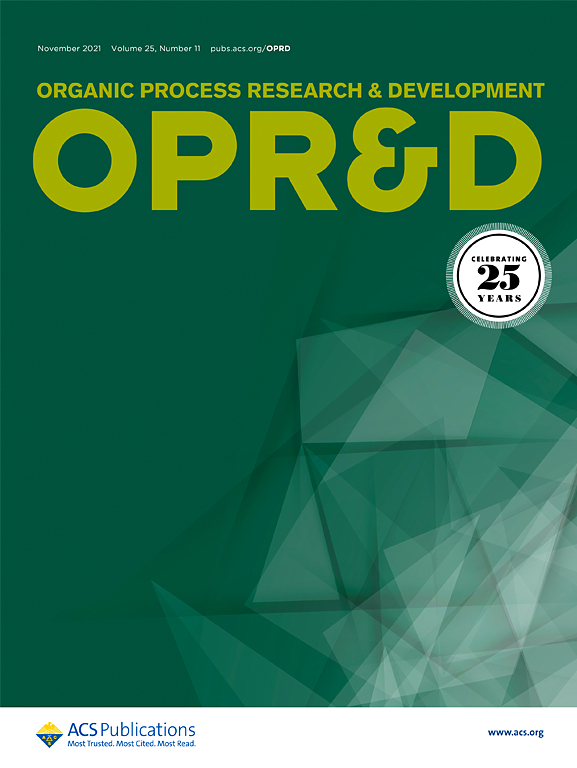From Lab Procedure to Industrial Reality: Continuous Flow Diisobutylaluminum Hydride Reduction of Esters to Aldehydes
IF 3.1
3区 化学
Q2 CHEMISTRY, APPLIED
引用次数: 0
Abstract
The selective partial reduction of esters to the corresponding aldehydes has been a long-standing challenge in the field of chemistry due to rapid reaction kinetics, high exothermicity, and generation of unstable intermediates. Batch reactors, with their limited heat transfer capabilities, necessitate careful temperature control and prolonged dosing of DIBAL-H, typically at very low temperatures (−70 to −50 °C). This process, especially on a plant scale, can take several hours and often results in considerable over-reduction to the alcohol product despite the cryogenic conditions. As industries aim to increase productivity and efficiency, the transition from laboratory-scale processes to larger-scale manufacturing becomes crucial. Herein, we report a pilot-scale DIBAL-H reduction of an ester to the corresponding aldehyde with product output ranging from 0.72 to 1.2 kg/h using the benefits of continuous flow chemistry. Furthermore, we demonstrate the advantages of 3D metal printing in fabricating the flow reactor, heat exchangers, and static mixers, leading to a straightforward scale-up of this highly reactive and exothermic chemical process demanding excellent heat and mass transfer properties.

从实验室程序到工业现实:连续流动二异丁基氢化铝还原酯到醛
由于快速反应动力学、高放热性和产生不稳定的中间体,选择性部分还原酯到相应的醛一直是化学领域的一个长期挑战。间歇式反应器的传热能力有限,需要仔细控制温度并延长DIBAL-H的加药时间,通常在极低的温度下(- 70至- 50℃)。这一过程,特别是在工厂规模上,可能需要几个小时,并且尽管在低温条件下,通常会导致相当大的酒精产品过度还原。随着工业的目标是提高生产力和效率,从实验室规模的过程到大规模制造的过渡变得至关重要。在这里,我们报告了一个中试规模的DIBAL-H还原酯为相应的醛,产品产量范围从0.72到1.2 kg/h,使用连续流化学的好处。此外,我们展示了3D金属打印在制造流动反应器、热交换器和静态混合器方面的优势,从而直接扩大了这种高活性和放热的化学过程,需要出色的传热和传质性能。
本文章由计算机程序翻译,如有差异,请以英文原文为准。
求助全文
约1分钟内获得全文
求助全文
来源期刊
CiteScore
6.90
自引率
14.70%
发文量
251
审稿时长
2 months
期刊介绍:
The journal Organic Process Research & Development serves as a communication tool between industrial chemists and chemists working in universities and research institutes. As such, it reports original work from the broad field of industrial process chemistry but also presents academic results that are relevant, or potentially relevant, to industrial applications. Process chemistry is the science that enables the safe, environmentally benign and ultimately economical manufacturing of organic compounds that are required in larger amounts to help address the needs of society. Consequently, the Journal encompasses every aspect of organic chemistry, including all aspects of catalysis, synthetic methodology development and synthetic strategy exploration, but also includes aspects from analytical and solid-state chemistry and chemical engineering, such as work-up tools,process safety, or flow-chemistry. The goal of development and optimization of chemical reactions and processes is their transfer to a larger scale; original work describing such studies and the actual implementation on scale is highly relevant to the journal. However, studies on new developments from either industry, research institutes or academia that have not yet been demonstrated on scale, but where an industrial utility can be expected and where the study has addressed important prerequisites for a scale-up and has given confidence into the reliability and practicality of the chemistry, also serve the mission of OPR&D as a communication tool between the different contributors to the field.

 求助内容:
求助内容: 应助结果提醒方式:
应助结果提醒方式:


